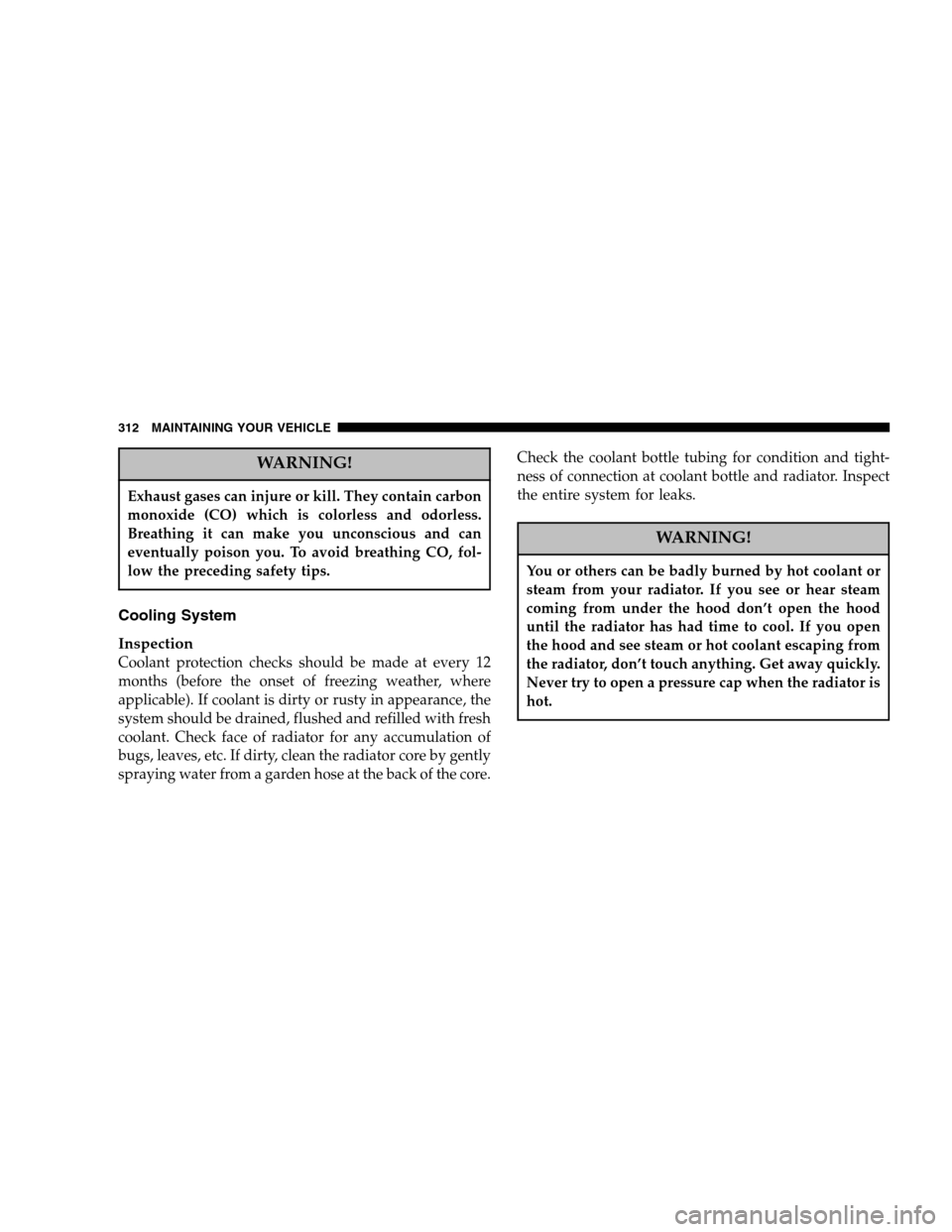Page 78 of 392

▫Manual Lumbar Support Adjustment — If
Equipped...........................109
▫Adjustable Head Restraints — Front Seating
Positions...........................109
▫6 - Way Power Seat Adjuster — Driver’s Side
Only..............................110
▫Club Cab/Quad Cab Rear Seat............112
▫Heated Seats — If Equipped.............112
�To Open And Close The Hood.............112
�Lights...............................114
▫Interior Lights.......................114
▫Battery Saver........................115
▫Headlamp Delay......................116
▫Headlights, Parking Lights, Panel Lights.....116▫Daytime Running Lights (Canada Only).....117
▫Lights-On Reminder...................117
▫Fog Lights — If Equipped...............117
▫Cargo Light — If Equipped..............118
�Multifunction Control Lever...............118
▫Turn Signals.........................118
▫Passing Light........................119
▫High Beam / Low Beam Select Switch......119
▫Windshield Wipers....................120
▫Windshield Washers...................121
�Tilt Steering Column....................122
�Electronic Speed Control — If Equipped......123
▫To Activate..........................123
78 UNDERSTANDING THE FEATURES OF YOUR VEHICLE
Page 112 of 392

Club Cab/Quad Cab Rear Seat
More cargo space is available by lifting up on the rear
seat cushion.
The Quad Cab rear seat is a 60/40 split cushion and full
back. Either cushion can be raised independently.
Heated Seats — If Equipped
The heated seat switches are located at the front of the
floor console. The engine must be running for the heated
seats to operate.
Each heated seat switch has two settings (HI and LOW).
Press the switch once to obtain the desired heating
position and press a second time in the same direction to
turn the heated seats OFF. If you do not purposefully
turn the switch OFF, the heating element in the seat will
remain activated until the ignition is turned off. The
indicators on the switch will illuminate when the heated
seats are in the (HI or LOW) position. Flashing telltale
lights on the switch indicate that the Heated Seat system
needs servicing.
TO OPEN AND CLOSE THE HOOD
To open the hood, two latches must be released. First pull
the hood release lever located under the left side of the
instrument panel.
Hood Release Lever Location
112 UNDERSTANDING THE FEATURES OF YOUR VEHICLE
Page 113 of 392
Then push the safety latch lever down while lifting the
grille with your right hand. It is located at the top center
of the grille just left of center.
Lift the hood and gas filled props will hold it open.To prevent possible damage, do not slam the hood to
close it. Use a firm downward push at the center front
edge of the hood to ensure that both latches engage.
Never drive your vehicle unless the hood is fully closed,
with both latches engaged.
WARNING!
If the hood is not fully latched, it could fly up when
the vehicle is moving and block your forward vision.
Be sure all hood latches are fully latched before
driving.
Secondary Latch Location (Push Down)
UNDERSTANDING THE FEATURES OF YOUR VEHICLE 113
3
Page 133 of 392

To set the variance: Turn the ignition ON and set the
display to “Compass/Temperature.” Press and hold the
RESET button approximately five seconds. The last vari-
ance zone number will be displayed. Press the STEP
button to select the new variance zone and press the
RESET button to resume normal operation.
Outside Temperature
Because the ambient temperature sensor is located un-
derhood, engine temperature can influence the displayed
temperature, therefore, temperature readings are slowly
updated when the vehicle speed is below 20 mph (30
km/h) or during stop and go driving.
GARAGE DOOR OPENER — IF EQUIPPED
The HomeLink�Universal Transceiver replaces up to
three remote controls (hand held transmitters) that operate
devices such as garage door openers, motorized gates, or
home lighting. It triggers these devices at the push of a
button. The Universal Transceiver operates off your vehi-
cle’s battery and charging system; no batteries are needed.
UNDERSTANDING THE FEATURES OF YOUR VEHICLE 133
3
Page 312 of 392

WARNING!
Exhaust gases can injure or kill. They contain carbon
monoxide (CO) which is colorless and odorless.
Breathing it can make you unconscious and can
eventually poison you. To avoid breathing CO, fol-
low the preceding safety tips.
Cooling System
Inspection
Coolant protection checks should be made at every 12
months (before the onset of freezing weather, where
applicable). If coolant is dirty or rusty in appearance, the
system should be drained, flushed and refilled with fresh
coolant. Check face of radiator for any accumulation of
bugs, leaves, etc. If dirty, clean the radiator core by gently
spraying water from a garden hose at the back of the core.Check the coolant bottle tubing for condition and tight-
ness of connection at coolant bottle and radiator. Inspect
the entire system for leaks.
WARNING!
You or others can be badly burned by hot coolant or
steam from your radiator. If you see or hear steam
coming from under the hood don’t open the hood
until the radiator has had time to cool. If you open
the hood and see steam or hot coolant escaping from
the radiator, don’t touch anything. Get away quickly.
Never try to open a pressure cap when the radiator is
hot.
312 MAINTAINING YOUR VEHICLE
Page 315 of 392

WARNING!
Never add coolant to the radiator when the engine is
overheated. Do not loosen or remove pressure cap to
cool overheated engine. The coolant is under pres-
sure and severe scalding could result.
Coolant Pressure Cap
The coolant pressure cap must be fully tightened to
prevent loss of coolant, and to insure that coolant will
return to the radiator from the coolant bottle.
The pressure cap should be inspected and cleaned if there
is any accumulation of foreign material on the sealing
surfaces.
WARNING!
The warning words “DO NOT OPEN HOT” on the
coolant pressure cap are a safety precaution. Heat
causes pressure to build up in the cooling system. To
prevent scalding or injury, do not remove the pres-
sure cap when the system is hot or under pressure.
Coolant Level
The coolant bottle system provides a quick visual method
for determining that the coolant level is adequate. With
the engine idling, and warmed to normal operating
temperature,�the level of the coolant on the overflow
bottle should be between the fluid level marks.�Check
the coolant level whenever the hood is raised.
The radiator normally remains completely full, so there is
no need to remove the pressure cap except checking
coolant freeze point or replacement with new antifreeze
MAINTAINING YOUR VEHICLE 315
7
Page 331 of 392
1. Open the hood.
2. Remove the 3 screws attaching the headlamp housing
to the inner panel.
3. Grasp the headlamp and pull firmly to disengage the
headlamp housing from the fender panel.
Removing Headlamp AssemblyRemoving Headlamp Assembly
MAINTAINING YOUR VEHICLE 331
7
Page 334 of 392
7. Reverse procedure to install new Headlamp bulb into
the headlamp assembly.
NOTE:These are Halogen bulbs. Take care not to touch
the bulb with your fingers. Body oils from your fingers
could cause excessive heat buildup which reduces bulb
life.
Front Park and Turn Signal Lamp.
•
Open the hood.
•Remove the (3) screws attaching the headlamp hous-
ing to the inner panel.
•Grasp the headlamp and pull firmly to disengage the
headlamp housing from the fender panel.
NOTE:It is not necessary to disconnect the connector to
replace this bulb. If the bulb socket needs replacement
disconnect the connector.
Disconnecting Headlamp Bulb Connector
334 MAINTAINING YOUR VEHICLE